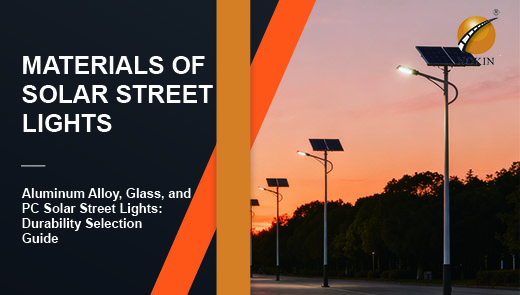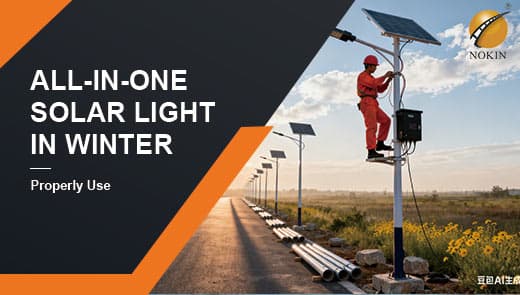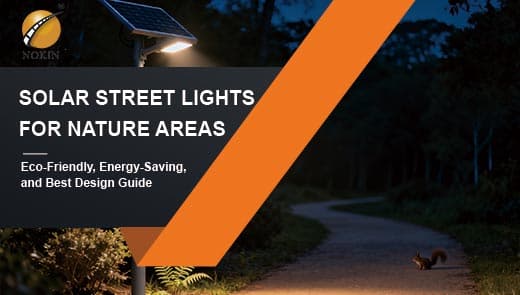What Is The Best Pole For Solar Power Street Lights
In the wave of global energy transition, solar street lights are rapidly replacing traditional street lights as the new favorite of municipal lighting due to their advantages of zero carbon emission and low maintenance cost. However, market research shows that about 42% of solar street light system failures are due to corrosion-resistant poles, ill-designed heights, or non-standardized base installations. From the coastal areas of the lamp post is rusted by salt spray, to typhoon prone areas lamp post collapse, and then poor lighting effect in commercial areas - the root cause of these problems, often lies in the lamp post selection does not match the scene demand. This article will systematically disassemble the core elements of solar street light pole selection, to provide scientific solutions for different environments.
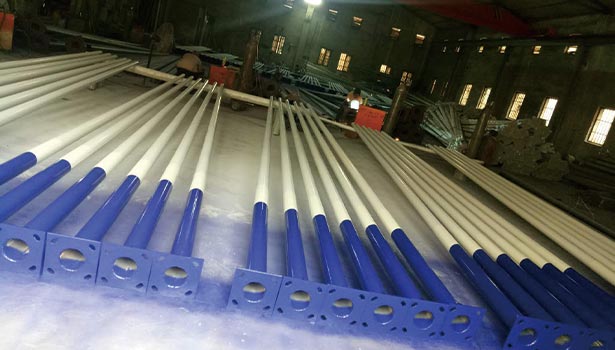
Material of the Pole
The material of the solar street light pole directly determines its service life, environmental resistance and maintenance cost. The following are some common and high quality materials for street light poles:
Galvanized Steel
Galvanized steel greatly enhances corrosion resistance by covering the steel surface with a zinc layer. The zinc layer insulates the steel from air and moisture in outdoor environments, preventing the steel from rusting and keeping it in good condition for long periods of time, even in humid and rainy areas. At the same time, the steel itself is strong enough to stably support the weight of the solar panels and lamps, making it ideal for scenarios where high load bearing and durability are sought.
Aluminum
Aluminum street light poles are best characterized by their light weight, which makes the transportation and installation process easier and can significantly reduce labor and logistics costs. Aluminum is also naturally resistant to corrosion, with a dense oxide film forming on its surface, blocking out external corrosive elements, making it suitable for most common environments, especially residential areas where ease of installation is a key requirement.
Stainless Steel
Stainless steel street light poles are known for their excellent resistance to rust, corrosion and fouling. Stainless steel maintains its stability in coastal areas where salt from evaporating seawater corrodes metals, and in industrial areas where airborne pollutants accelerate metal deterioration. In addition, its simple and aesthetically pleasing appearance enhances the overall tone of the area.
Fiberglass
Fiberglass street light poles are lightweight but strong, and can withstand strong winds in high wind areas with their own toughness. At the same time, it is a non-conductive material, in the presence of electrical hazards, such as near high-voltage power lines, the use of fiberglass poles can effectively avoid the risk of electrocution, to protect the safety of personnel and equipment.
|
Material |
Key Advantages |
Typical Application Scenarios |
|
Galvanized Steel |
High durability, corrosion-resistant (zinc coating), strong load-bearing capacity; withstands harsh weather |
High wind areas, high humidity regions, major roads, large parking lots |
|
Aluminum |
Lightweight and easy to install, naturally corrosion-resistant, low transport cost, simple maintenance |
Residential paths, gardens, commercial pedestrian streets |
|
Stainless Steel |
Highly rust and corrosion resistant (salt spray and industrial pollution), sleek appearance, long lifespan |
Coastal areas, industrial zones, premium commercial plazas |
|
Fiberglass |
Lightweight yet strong, excellent wind resistance (great flexibility), non-conductive (high safety), chemical-resistant |
Windy mountain areas, typhoon-prone coasts, near high-voltage zones |
Height of the Pole
The height of a street light pole needs to be selected based on the lighting needs and environmental characteristics of the specific scenario in which it will be used:
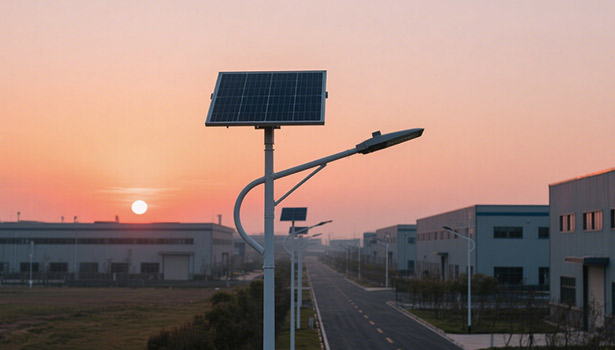
Residential Pathways and Gardens
In residential gardens, pathways, or driveway lighting, a pole height of 3 - 7 ft (approx. 0.9 - 2.1 m) is appropriate. This height focuses light on the ground, clearly illuminating the path of travel and avoiding dead spots. At the same time, the low level of lighting reduces light dispersion, allowing for safe nighttime travel without disturbing residents with too much light.
Street Lighting and Parking Lots
Streets and parking lots require high levels of visibility and safety, typically requiring 12 - 30 ft (3.7 - 9.1 m) street light poles. The exact height requires a combination of pole spacing, lighting technology, and the width of the area. For example, wider streets or large parking lots will require taller poles to ensure adequate light coverage.
Commercial Outdoor Areas
In commercial areas such as outdoor rest areas, walkways, or entrances, pole heights of 10 - 20 feet (approximately 3 - 6 meters) can provide adequate illumination and create a welcoming, comfortable atmosphere that attracts customers to linger and enhances the attractiveness of the commercial area.
Security Lighting
For lighting where security is the primary purpose, pole heights vary greatly depending on the specific needs. In large parking lots, industrial parks, and other areas where large areas need to be monitored, a height of 20 - 30 feet (approximately 6 - 9 meters) is critical. This height allows the lighting equipment to stand tall and provide wide angle coverage, eliminating blind spots in hidden areas such as corners of fences and behind vehicles. Bright and uniform light, together with high-definition surveillance equipment, can clearly capture the movement of people and vehicles, timely detection of potential threats, and significantly improve the ability of regional security.
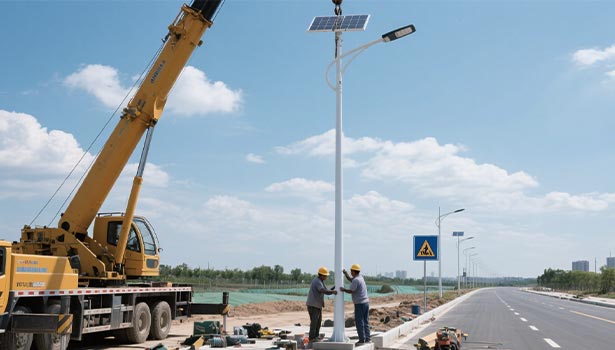
Sports and Recreational Fields
Stadiums, large sports fields and other areas are vast, in order to ensure that there is no shadow, no glare, street light pole height is usually 40 - 100 feet (about 12 - 30 meters) or even higher. Through the high placement of lights and professional light distribution design, a comprehensive and uniform lighting effect can be realized to ensure that sports and spectators are not disturbed by the light.
Design and Aesthetic Considerations
The design of street light poles is not only about function, but also about aesthetics. Modern street light poles with minimalist geometric shapes can strengthen the sense of technology and fashionable atmosphere of new city districts and technology parks by virtue of their sharp lines and metallic texture. And the carving of delicate patterns, the use of antique copper color of the retro street light poles, and the historical district of the green brick tile, classical garden pavilions and pavilions complement each other. In addition, the matte finish can reduce reflective interference, the glossy material is suitable for highlighting the modern sense, and the imitation wood grain surface can be naturally integrated into the ecological landscape. By echoing the landscape greenery and architectural style, street light poles can be the finishing touch to enhance the environment.
Wind Load and Stability
In coastal typhoon areas or inland windy areas, the wind load performance of street light poles directly affects the safety of use. Wind load rating is divided by wind speed, the higher the rating, the stronger the ability of street light poles to withstand strong winds. Galvanized steel, with its high strength and toughness, can withstand the impact of strong winds when combined with deeply buried concrete foundations. Fiberglass street light poles are lightweight and flexible, and with the professional multi-directional anchoring system, they can maintain structural stability in high winds. Combined with the scientific installation process, the two can significantly reduce the risk of street lights tipping over and being damaged in extreme weather, guarding the safety of public areas.
Solar Street Light Pole Foundation and Installation
Importance of Concrete Foundation
A solid foundation is the core guarantee for the stable operation of solar street light pole, which directly affects its safety and service life. Concrete foundation is preferred because of its high strength, high stability and good durability. The size and depth of the foundation should be determined according to the height and weight of the street light pole and local geological conditions. Generally, a square or round pit is dug, a reinforced frame is built in, and concrete is poured to form a solid base to ensure that the pole can withstand wind, earthquakes and other external forces.
Pre-drilled Hole Design Improves Installation Accuracy
Modern solar street light poles are mostly equipped with pre-drilled holes, which can be accurately docked with the foundation pre-embedded parts, effectively reducing the errors generated by on-site hole cutting, and at the same time, reducing the cost of installation time. This design makes the installation process more standardized and ensures installation quality and efficiency even in complex terrain.
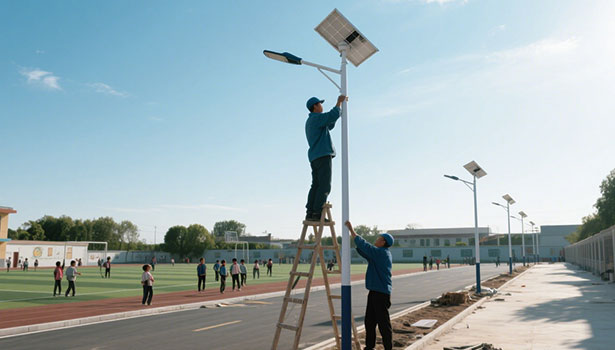
Standardized Components Simplify the Installation Process
Standardized installation components are like “building blocks”, whether it's a single courtyard street light installation or a large-scale street lighting system build, construction workers can quickly assemble them according to a unified standard, without the need for complex customization operations. From transportation to on-site assembly, the standardized process significantly reduces labor and time costs.
Modular Design Optimizes the Construction Experience
Some of the advanced products adopt modular design, and the components such as light poles, solar panels and lamps are transported separately, and the installation can be completed through simple splicing after arriving at the site. This not only reduces the difficulty of transportation, but also significantly shortens the construction period, so that the solar street lights can be put into use faster to meet the lighting needs of different scenes.
Durability and Maintenance
The durability and maintenance needs of street light poles differ from one material to another. Aluminum poles require only simple cleaning. Galvanized steel poles need to be repaired in time to prevent rusting if the coating is damaged. Stainless steel poles are relatively easy to maintain, but they do require regular cleaning in particular polluted environments. Fiberglass poles should avoid sharp objects collision. At the same time, regular inspection of street light poles is crucial:
Check for Damage
Regular monthly inspection is the key to ensure the safe operation of solar street light poles. Focus on checking whether there are cracks in the pole body, minor cracks may be gradually expanded due to external forces, threatening the structural stability of the pole. Check whether the bolts, nuts and other components are loose, if not reinforced in time, may lead to lamps and lanterns fall. Check whether the line is broken, aging or broken lines are prone to short circuits, leakage and other safety hazards. Once the above problems are found, repair or replacement measures should be taken immediately to avoid minor problems from turning into serious failures or safety accidents.
Check for Corrosion
Street light poles made of metal are exposed to the outdoors for a long time, and are very susceptible to corrosion caused by environmental factors. During daily inspection, you need to carefully observe the surface of the pole to see if there is any rust, discoloration or peeling of the coating, etc. Even if the corrosion is slight, you should check the surface of the pole to see if it has been damaged. Even slight rust, if not treated in time, will accelerate the damage of the metal structure. After the discovery of signs of corrosion, the rusted parts can be treated by grinding, spraying anti corrosion coating, etc., to form a protective film to isolate the air and moisture, effectively preventing the spread of corrosion, prolonging the service life of the street light pole, and ensuring that it continues to play a stable role.
Choosing the best solar street light pole requires comprehensive consideration of material, height, design, stability, foundation installation and durable maintenance and other aspects. Only by comprehensively assessing the needs of the use of the scene and environmental characteristics, can we pick the right street light pole, so that the solar street light to maximize the effectiveness of the various types of places to provide safe, efficient and beautiful lighting services.

